SUZUKI IGNIS 2022 Repair Manual
Manufacturer: SUZUKI, Model Year: 2022, Model line: IGNIS, Model: SUZUKI IGNIS 2022Pages: 505, PDF Size: 8.36 MB
Page 61 of 505
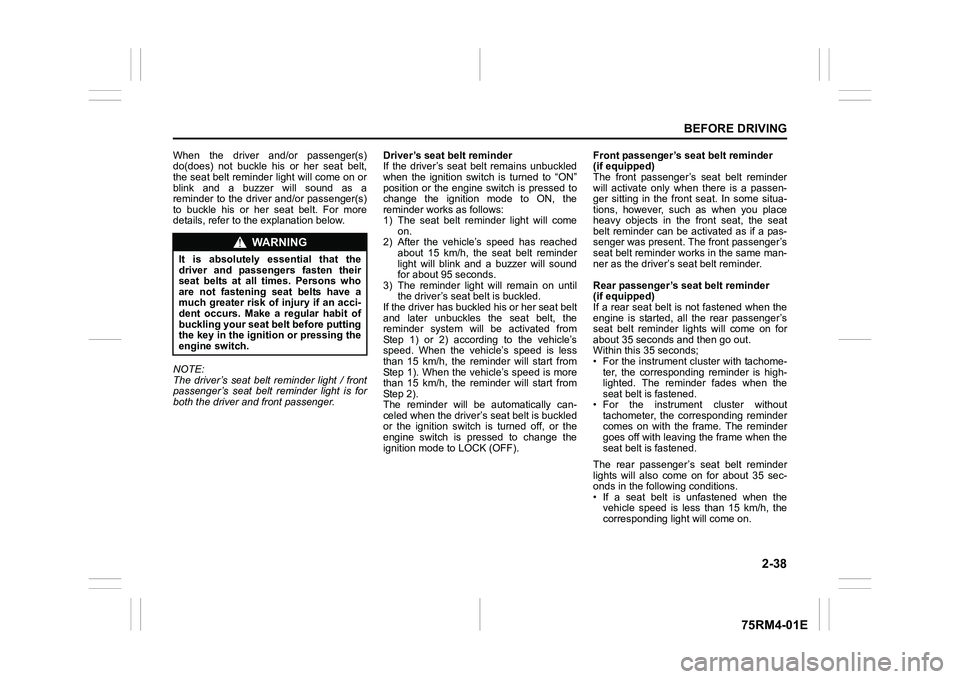
2-38
BEFORE DRIVING
75RM4-01E
When the driver and/or passenger(s)
do(does) not buckle his or her seat belt,
the seat belt reminder light will come on or
blink and a buzzer will sound as a
reminder to the driver and/or passenger(s)
to buckle his or her seat belt. For more
details, refer to the explanation below.
NOTE:
The driver’s seat belt reminder light / front
passenger’s seat belt reminder light is for
both the driver and front passenger. Driver’s seat belt reminder
If the driver’s seat belt remains unbuckled
when the ignition switch is turned to “ON”
position or the engine switch is pressed to
change the ignition mode to ON, the
reminder works as follows:
1) The seat belt reminder light will come
on.
2) After the vehicle’s speed has reached
about 15 km/h, the seat belt reminder
light will blink and a buzzer will sound
for about 95 seconds.
3) The reminder light will remain on until the driver’s seat belt is buckled.
If the driver has buckled his or her seat belt
and later unbuckles the seat belt, the
reminder system will be activated from
Step 1) or 2) according to the vehicle’s
speed. When the vehicle’s speed is less
than 15 km/h, the reminder will start from
Step 1). When the vehicle’s speed is more
than 15 km/h, the reminder will start from
Step 2).
The reminder will be automatically can-
celed when the driver’s seat belt is buckled
or the ignition switch is turned off, or the
engine switch is pressed to change the
ignition mode to LOCK (OFF). Front passenger’s seat belt reminder
(if equipped)
The front passenger’s seat belt reminder
will activate only when there is a passen-
ger sitting in the front seat. In some situa-
tions, however, such as when you place
heavy objects in the front seat, the seat
belt reminder can be activated as if a pas-
senger was present. The front passenger’s
seat belt reminder wo
rks in the same man-
ner as the driver’s seat belt reminder.
Rear passenger’s seat belt reminder
(if equipped)
If a rear seat belt is not fastened when the
engine is started, all the rear passenger’s
seat belt reminder lights will come on for
about 35 seconds and then go out.
Within this 35 seconds;
• For the instrument c luster with tachome-
ter, the corresponding reminder is high-
lighted. The reminder fades when the
seat belt is fastened.
• For the instrum ent cluster without
tachometer, the corresponding reminder
comes on with the frame. The reminder
goes off with leaving the frame when the
seat belt is fastened.
The rear passenger’s seat belt reminder
lights will also come on for about 35 sec-
onds in the following conditions.
• If a seat belt is unfastened when the vehicle speed is less than 15 km/h, the
corresponding light will come on.
WA R N I N G
It is absolutely essential that the
driver and passengers fasten their
seat belts at all times. Persons who
are not fastening seat belts have a
much greater risk of injury if an acci-
dent occurs. Make a regular habit of
buckling your seat belt before putting
the key in the ignition or pressing the
engine switch.
Page 62 of 505
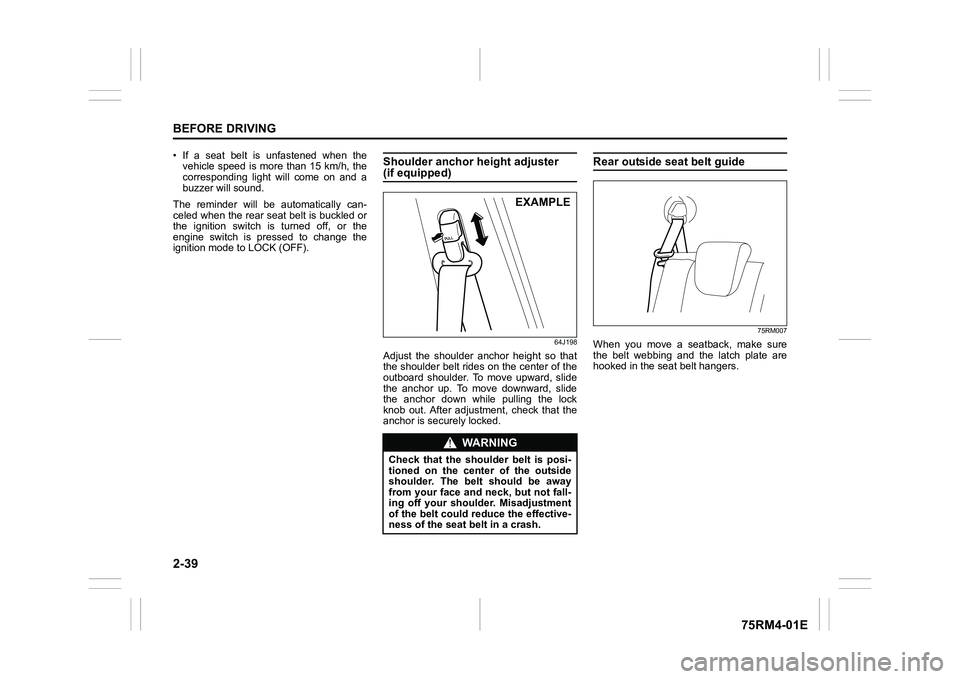
2-39BEFORE DRIVING
75RM4-01E
• If a seat belt is unfastened when thevehicle speed is more than 15 km/h, the
corresponding light will come on and a
buzzer will sound.
The reminder will be automatically can-
celed when the rear seat belt is buckled or
the ignition switch is turned off, or the
engine switch is pressed to change the
ignition mode to LOCK (OFF).
Shoulder anchor height adjuster (if equipped)
64J198
Adjust the shoulder anchor height so that
the shoulder belt rides on the center of the
outboard shoulder. To move upward, slide
the anchor up. To move downward, slide
the anchor down while pulling the lock
knob out. After adjustment, check that the
anchor is securely locked.
Rear outside seat belt guide
75RM007
When you move a seatback, make sure
the belt webbing and the latch plate are
hooked in the seat belt hangers.
WA R N I N G
Check that the shoulder belt is posi-
tioned on the cent er of the outside
shoulder. The belt should be away
from your face and neck, but not fall-
ing off your shoulder. Misadjustment
of the belt could reduce the effective-
ness of the seat belt in a crash.
EXAMPLE
Page 63 of 505
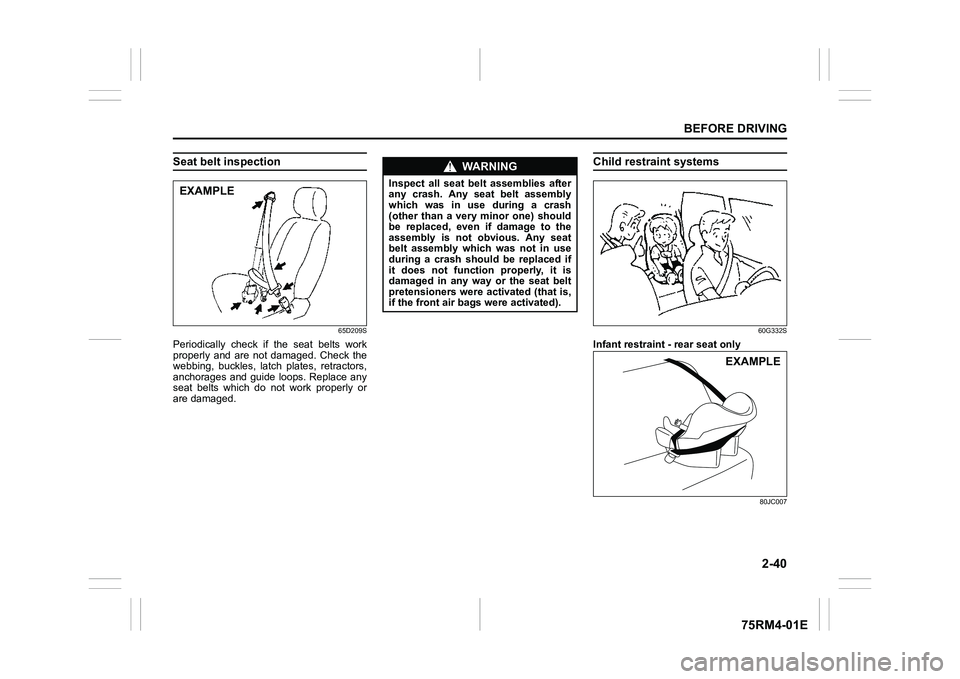
2-40
BEFORE DRIVING
75RM4-01E
Seat belt inspection
65D209S
Periodically check if the seat belts work
properly and are not damaged. Check the
webbing, buckles, latch plates, retractors,
anchorages and guide loops. Replace any
seat belts which do not work properly or
are damaged.
Child restraint systems
60G332S
Infant restraint - rear seat only
80JC007
EXAMPLE
WA R N I N G
Inspect all seat belt assemblies after
any crash. Any seat belt assembly
which was in use during a crash
(other than a very minor one) should
be replaced, even if damage to the
assembly is not obvious. Any seat
belt assembly which was not in use
during a crash should be replaced if
it does not function properly, it is
damaged in any way or the seat belt
pretensioners were activated (that is,
if the front air bags were activated).
EXAMPLE
Page 64 of 505
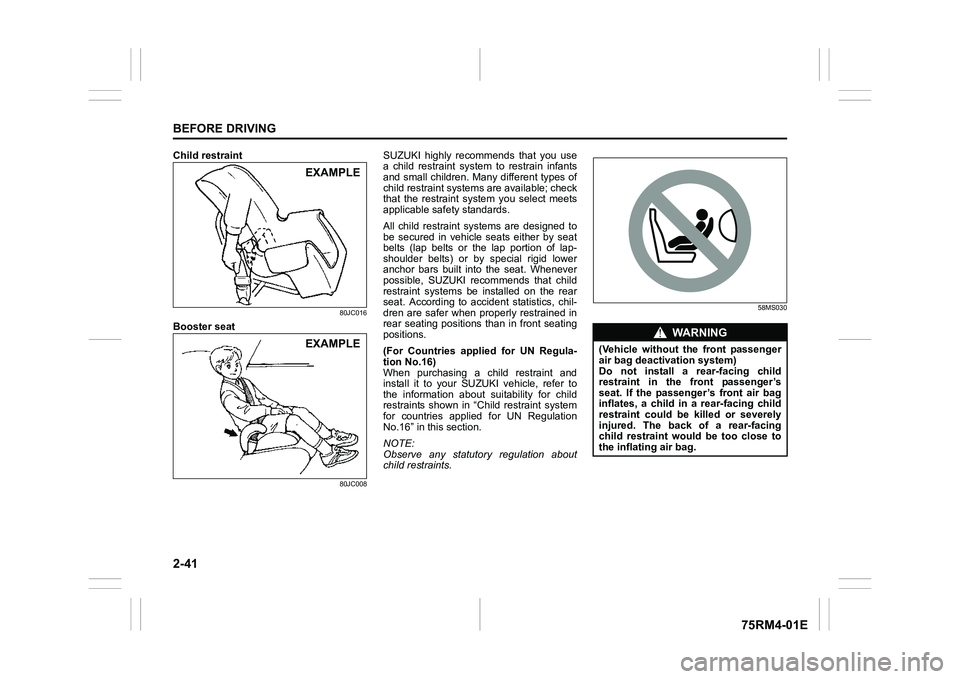
2-41BEFORE DRIVING
75RM4-01E
Child restraint
80JC016
Booster seat
80JC008
SUZUKI highly recommends that you use
a child restraint system to restrain infants
and small children. Many different types of
child restraint systems are available; check
that the restraint syst em you select meets
applicable safety standards.
All child restraint systems are designed to
be secured in vehicle seats either by seat
belts (lap belts or the lap portion of lap-
shoulder belts) or by special rigid lower
anchor bars built into the seat. Whenever
possible, SUZUKI recommends that child
restraint systems be installed on the rear
seat. According to accident statistics, chil-
dren are safer when properly restrained in
rear seating positions than in front seating
positions.
(For Countries applied for UN Regula-
tion No.16)
When purchasing a child restraint and
install it to your SUZUKI vehicle, refer to
the information about suitability for child
restraints shown in “Child restraint system
for countries applied for UN Regulation
No.16” in this section.
NOTE:
Observe any statutory regulation about
child restraints.
58MS030
EXAMPLEEXAMPLE
WA R N I N G
(Vehicle without the front passenger
air bag deactivation system)
Do not install a rear-facing child
restraint in the front passenger’s
seat. If the passenger’s front air bag
inflates, a child in a rear-facing child
restraint could be killed or severely
injured. The back of a rear-facing
child restraint would be too close to
the inflating air bag.
Page 65 of 505
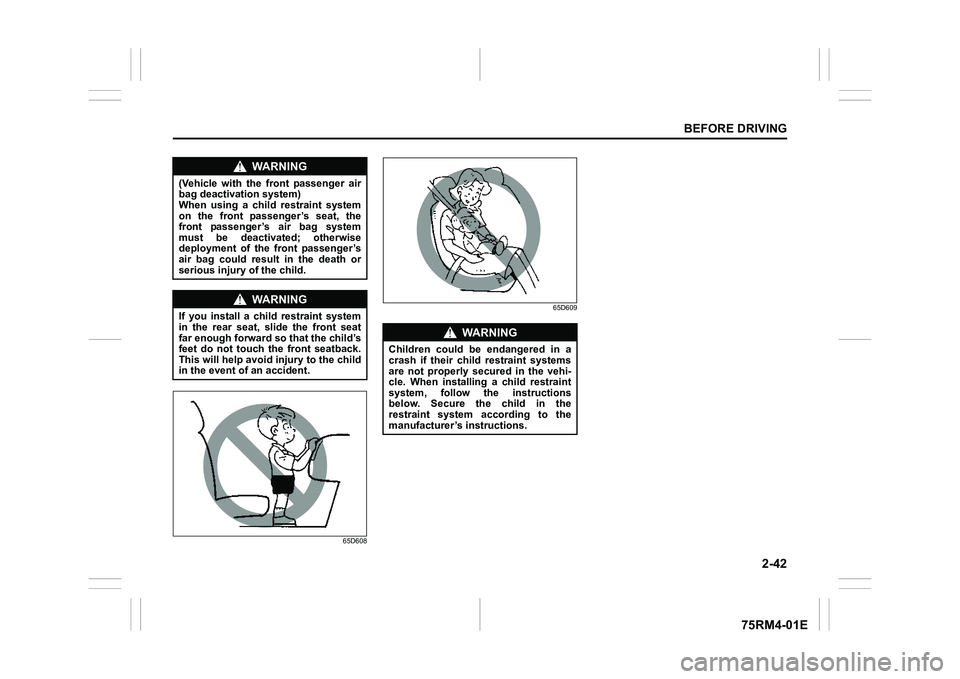
2-42
BEFORE DRIVING
75RM4-01E
65D60865D609
WA R N I N G
(Vehicle with the front passenger air
bag deactivation system)
When using a child restraint system
on the front passenger’s seat, the
front passenger’s air bag system
must be deactivated; otherwise
deployment of the
front passenger’s
air bag could result in the death or
serious injury of the child.
WA R N I N G
If you install a child restraint system
in the rear seat, slide the front seat
far enough forward so that the child’s
feet do not touch the front seatback.
This will help avoid injury to the child
in the event of an accident.
WA R N I N G
Children could be endangered in a
crash if their child restraint systems
are not properly secured in the vehi-
cle. When installing a child restraint
system, follow the instructions
below. Secure the child in the
restraint system according to the
manufacturer’s instructions.
Page 66 of 505
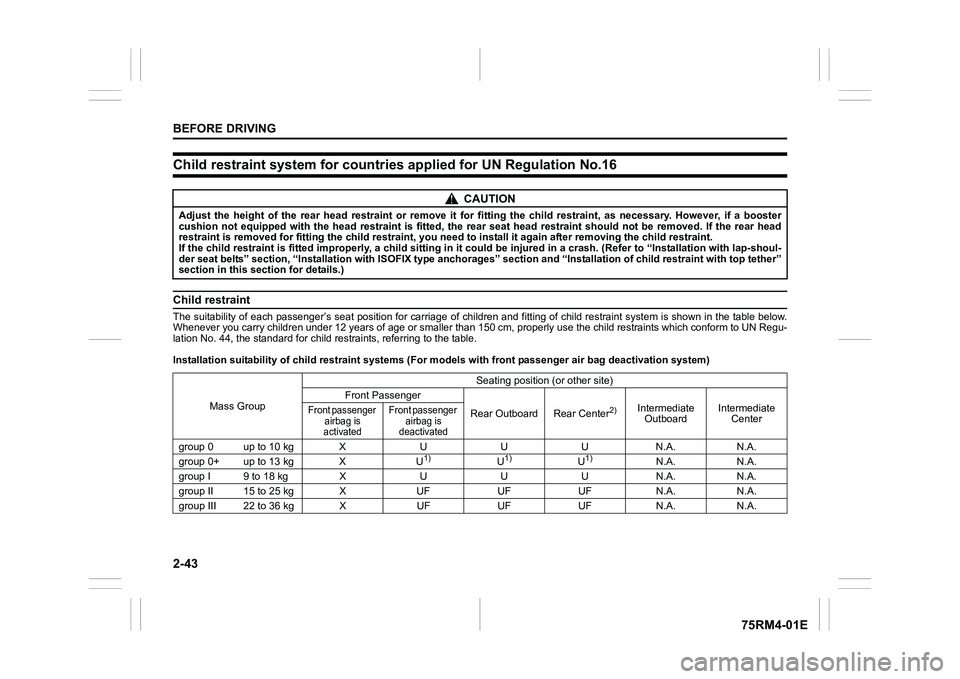
2-43BEFORE DRIVING
75RM4-01E
Child restraint system for countries applied for UN Regulation No.16Child restraintThe suitability of each passenger’s seat position for carriage of children and fitting of child restraint system is shown in t he table below.
Whenever you carry children under 12 years of age or smaller th an 150 cm, properly use the child restraints which conform to UN Regu-
lation No. 44, the standard for child restraints, referring to the table.
Installation suitability of chi ld restraint systems (For models with front passenger air bag deactivation system)
CAUTION
Adjust the height of the rear head restraint or remove it for f itting the child restraint, as necessary. However, if a booster
cushion not equipped with the head restraint is fitted, the rea r seat head restraint should not be removed. If the rear head
restraint is removed for fitting the child restraint, you need to install it again after removing the child restraint.
If the child restraint is fitted improperly, a child sitting in it could be injured in a crash. (Refer to “Installation with l ap-shoul-
der seat belts” section, “Instal lation with ISOFIX type anchora ges” section and “Installation of child restraint with top teth er”
section in this sect ion for details.)
Mass Group Seating position (or other site)
Front Passenger
Rear Outboard Rear Center
2)
Intermediate Outboard Intermediate
Center
Front passenger
airbag is
activated Front passenger
airbag is
deactivated
group 0 up to 10 kg X U U U N.A. N.A.
group 0+ up to 13 kg X U
1)
U1)
U1)
N.A. N.A.
group I 9 to 18 kg X U U U N.A. N.A.
group II 15 to 25 kg X UF UF UF N.A. N.A.
group III 22 to 36 kg X UF UF UF N.A. N.A.
Page 67 of 505
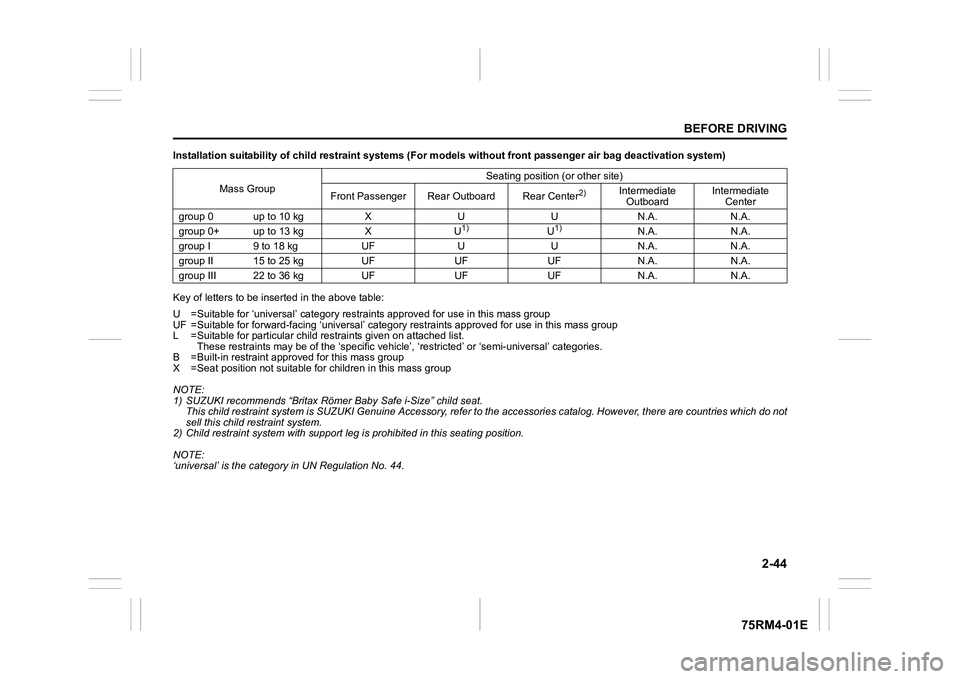
2-44
BEFORE DRIVING
75RM4-01E
Installation suitability of child restraint systems (For models without front passenger air bag deactivation system)
Key of letters to be inse rted in the above table:
U =Suitable for ‘universal’ category restraints approved for use in this mass group
UF =Suitable for forward-facing ‘ universal’ category restraints approved for use in this mass group
L =Suitable for particular child r estraints given on attached list.
These restraints may be of the ‘ specific vehicle’, ‘restricted’ or ‘semi-universal’ categories.
B =Built-in restraint approved for this mass group
X =Seat position not suitable fo r children in this mass group
NOTE:
1) SUZUKI recommends “Britax Röme r Baby Safe i-Size” child seat.
This child restraint system is SUZUKI Genu ine Accessory, refer to the accessories cata log. However, there are countries which d o not
sell this child restraint system.
2) Child restraint system with support leg is prohibited in this seating position.
NOTE:
‘universal’ is the category in UN Regulation No. 44. Mass Group
Seating position (or other site)
Front Passenger Rear Outboard Rear Center
2)
Intermediate Outboard Intermediate
Center
group 0 up to 10 kg X U U N.A. N.A.
group 0+ up to 13 kg X U
1)
U1)
N.A. N.A.
group I 9 to 18 kg UF U U N.A. N.A.
group II 15 to 25 kg UF UF UF N.A. N.A.
group III 22 to 36 kg UF UF UF N.A. N.A.
Page 68 of 505
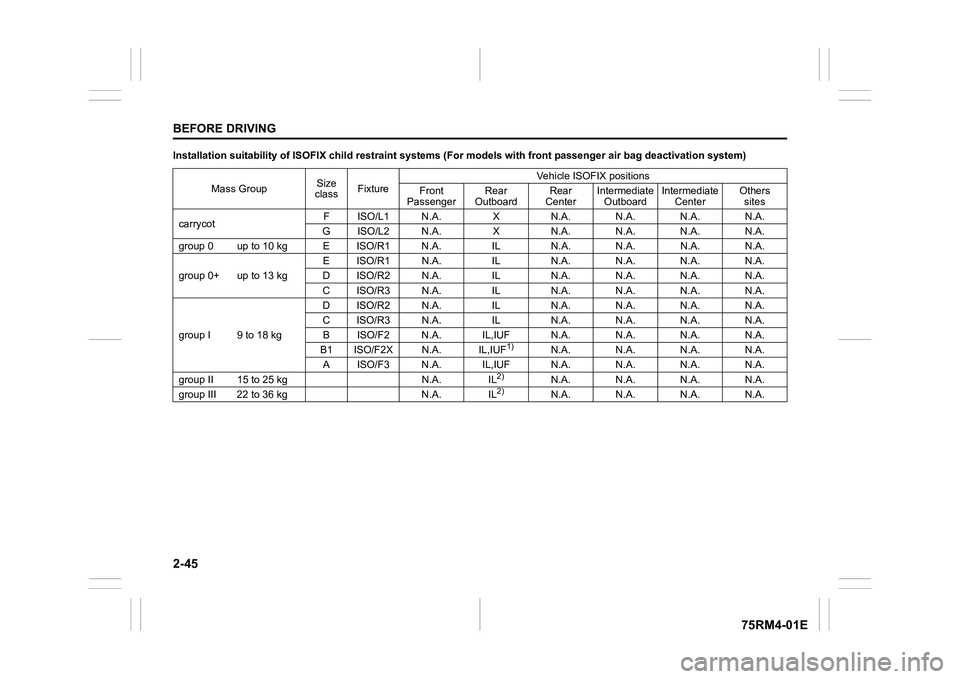
2-45BEFORE DRIVING
75RM4-01E
Installation suitability of ISOFIX child restraint systems (For models with front passenger air bag deactivation system)
Mass Group Size
class Fixture Vehicle ISOFIX positions
Front
Passenger Rear
Outboard Rear
Center Intermediate
Outboard Intermediate
Center Others
sites
carrycot F ISO/L1 N.A. X N.A. N.A. N.A. N.A.
G ISO/L2 N.A. X N.A. N.A. N.A. N.A.
group 0 up to 10 kg E ISO/R1 N.A. IL N.A. N.A. N.A. N.A.
group 0+ up to 13 kg E ISO/R1 N.A. IL N.A. N.A. N.A. N.A.
D ISO/R2 N.A. IL N.A. N.A. N.A. N.A.
C ISO/R3 N.A. IL N.A. N.A. N.A. N.A.
group I 9 to 18 kg D ISO/R2 N.A. IL N.A. N.A. N.A. N.A.
C ISO/R3 N.A. IL N.A. N.A. N.A. N.A.
B ISO/F2 N.A. IL,IUF N.A. N.A. N.A. N.A.
B1 ISO/F2X N.A. IL,IUF
1)
N.A. N.A. N.A. N.A.
A ISO/F3 N.A. IL,IUF N.A. N.A. N.A. N.A.
group II 15 to 25 kg N.A. IL
2)
N.A. N.A. N.A. N.A.
group III 22 to 36 kg N.A. IL
2)
N.A. N.A. N.A. N.A.
Page 69 of 505
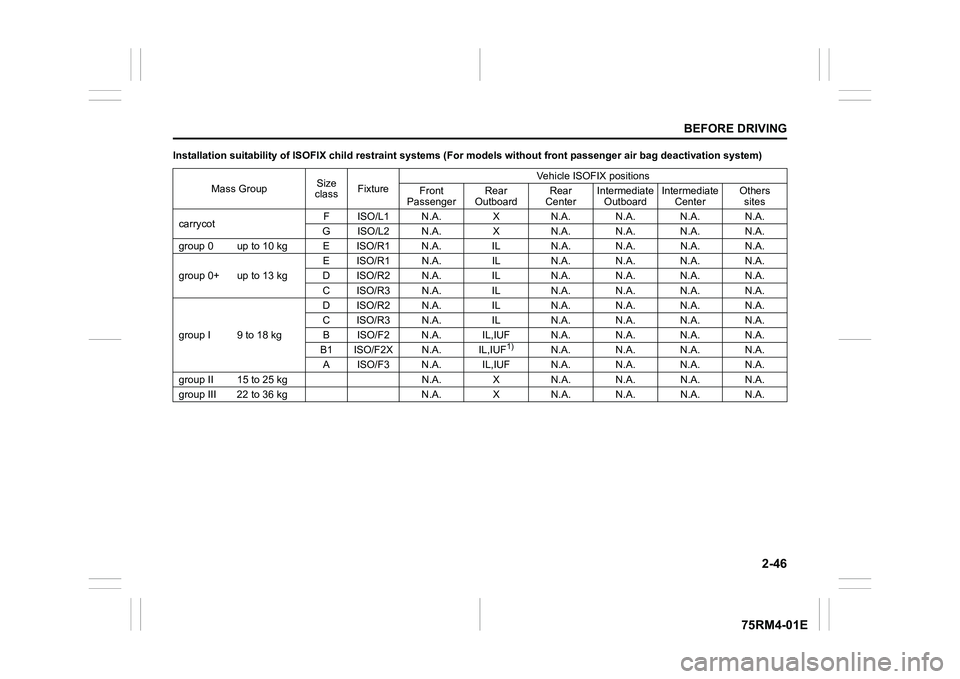
2-46
BEFORE DRIVING
75RM4-01E
Installation suitability of ISOFIX child restraint systems (For models without front passenge r air bag deactivation system)
Mass Group Size
class Fixture Vehicle ISOFIX positions
Front
Passenger Rear
Outboard Rear
Center Intermediate
Outboard Intermediate
Center Others
sites
carrycot F ISO/L1 N.A. X N.A. N.A. N.A. N.A.
G ISO/L2 N.A. X N.A. N.A. N.A. N.A.
group 0 up to 10 kg E ISO/R1 N.A. IL N.A. N.A. N.A. N.A.
group 0+ up to 13 kg E ISO/R1 N.A. IL N.A. N.A. N.A. N.A.
D ISO/R2 N.A. IL N.A. N.A. N.A. N.A.
C ISO/R3 N.A. IL N.A. N.A. N.A. N.A.
group I 9 to 18 kg D ISO/R2 N.A. IL N.A. N.A. N.A. N.A.
C ISO/R3 N.A. IL N.A. N.A. N.A. N.A.
B ISO/F2 N.A. IL,IUF N.A. N.A. N.A. N.A.
B1 ISO/F2X N.A. IL,IUF
1)
N.A. N.A. N.A. N.A.
A ISO/F3 N.A. IL,IUF N.A. N.A. N.A. N.A.
group II 15 to 25 kg N.A. X N.A. N.A. N.A. N.A.
group III 22 to 36 kg N .A. X N.A. N.A. N.A. N.A.
Page 70 of 505
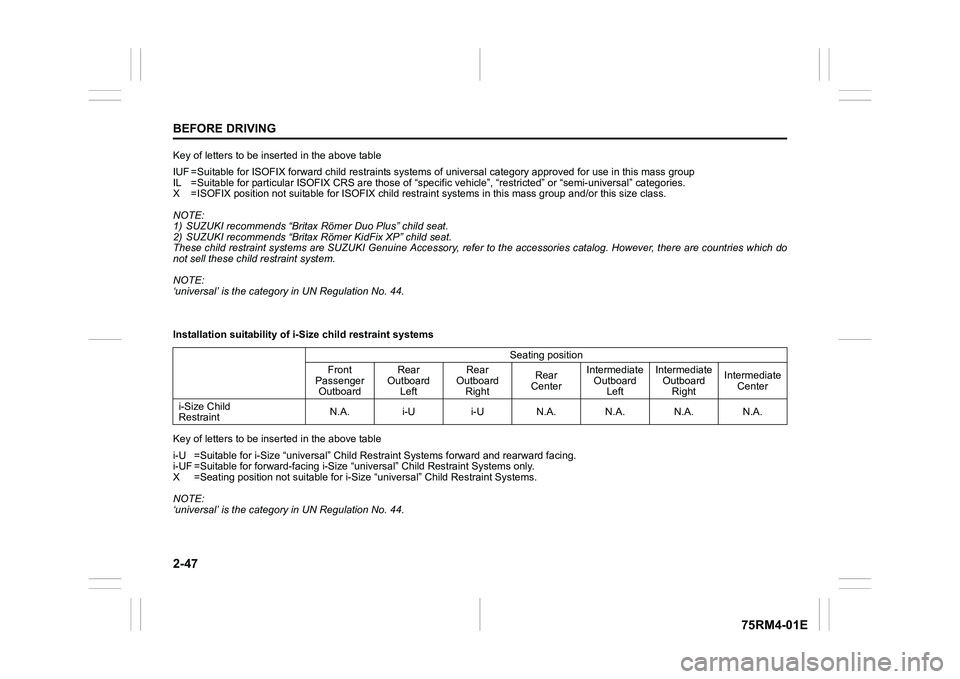
2-47BEFORE DRIVING
75RM4-01E
Key of letters to be inserted in the above table
IUF =Suitable for ISOFIX forward child restraints systems of universal category approved for use in this mass group
IL =Suitable for particular ISOFI X CRS are those of “specific vehicle”, “restricted” or “semi-universal” categories.
X =ISOFIX position not suitable fo r ISOFIX child restraint systems in this mass group and/or this size class.
NOTE:
1) SUZUKI recommends “Britax Römer Duo Plus” child seat.
2) SUZUKI recommends “Britax Römer KidFix XP” child seat.
These child restraint systems are SUZUKI Ge nuine Accessory, refer to the accessories catalog. However, there are countries which do
not sell these child restraint system.
NOTE:
‘universal’ is the category in UN Regulation No. 44.
Installation suitability of i-Size child restraint systems
Key of letters to be inse rted in the above table
i-U =Suitable for i-Siz e “universal” Child Restraint Systems for ward and rearward facing.
i-UF =Suitable for forward-facing i-Size “universal” Child Restraint Systems only.
X =Seating position not suitable for i-Size “universal” Child Re straint Systems.
NOTE:
‘universal’ is the category in UN Regulation No. 44. Seating position
Front
Passenger Outboard Rear
Outboard Left Rear
Outboard Right Rear
Center Intermediate
Outboard Left Intermediate
Outboard Right Intermediate
Center
i-Size Child
Restraint N.A. i-U i-U N.A. N.A. N.A. N.A.